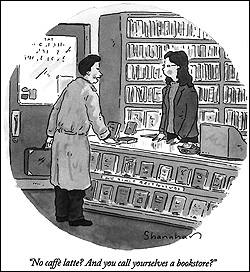Numbers don’t lie. Between its founding in 1925 and February of this year, The New Yorker published 68,647 cartoons. Reprinting them would fill several bookshelves, but they fit nicely onto the two CD-ROMs included in this single volume containing over 2,000 standouts from the magazine’s 79-year history. Filled with talking dogs, randy industrialists, snooty urbanites, and mountaintop holy men, that leviathan is The Complete Cartoons of The New Yorker (Black Dog & Leventhal, $60). I haven’t had time yet to count, but I suspect there are at least 100 ways in which the natives hope to appease the angry volcano gods; perhaps 200 excuses drunken businessmen offer before their wives let loose with the rolling pin; possibly around 400 questions from newbies in heaven or hell; then maybe 500 variations on the guy crawling through a desert. Anything having to do with sex—countless.
The magazine’s cartoon editor, Robert Mankoff, divides the printed volume by decade. (You can search the discs by various criteria.) Contributors including Calvin Trillin, Roger Angell, and John Updike offer little introductory essays to each. As you browse chronologically, the panels reflect America’s history from top hats to breadlines, from GIs on leave to suburbanites at home, from gray flannel suits to women’s lib, and so on. What’s topical changes regularly; there are sidebar sections on drinking, television, the space race, the Internet, and so forth. The artists have their seasons, too: Peter Arno in the gin- swilling era; Saul Steinberg’s absurdist postwar collages; Charles Addams’ haunted houses; and, today, Maria Acocella’s skinny scheming martini girls.
What’s funny, enduringly funny, may depend on The New Yorker‘s position itself. It’s not a matter of laughing down at those less sophisticated types—today we’d call them red-staters—who don’t read the magazine. Rather, it’s the sense of membership, the few mocking the few, a shared sense of humor. Upper West Side liberals laugh at Edward Koren’s fuzzy, bearded Upper West Side liberals. Patients and analysts alike can appreciate the myriad couch-related cartoons. Anyone who’s ever been snubbed at an exclusive cocktail party enjoys seeing someone else cut even lower. Parents caught between their insane parents and unreasonable kids somehow know that Roz Chast understands their lives. It’s a kind of solidarity, a club comprising literate types who habitually read the cartoons before the articles in The New Yorker. The smart stuff can always wait, we tell ourselves. What’s the good in having an education if you can’t ignore the ever- pressing seriousness of the world?








